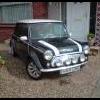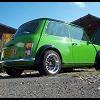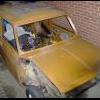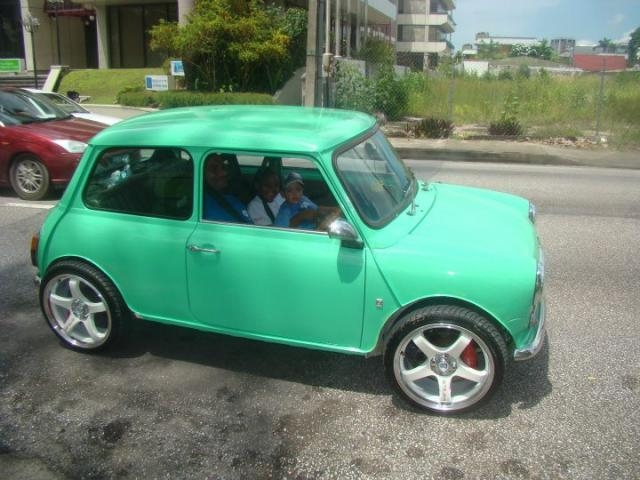I found this on mirca.org so thought I'd post. It's not all relevant to mini owners, but I thought I'd leave the extra info incase some crazy person wants to turbo one!
The giude!!!
this is all the info on tuning a micra from a range of soure a very littel bit buy me!!!!
Tuning your K11 - FAQs
Many many many thanks to Ian for posting this guide. Should answer any questions you have about getting to 100bhp from your 1.3 K11!
Table of Contents
1. Tuning your 1.3 K11
2. Why the CG13DE?
3. Induction
4. Exhaust
5. But I want more power!
Tuning your 1.3 K11
So you own a micra and you want more power right? You need to start somewhere and i would suggest with a 1.3 litre 16 valve micra unit also known as the CG13de. No matter what your mates or anyone else says, this is a cracking little engine no doubt. It produces a nice 75bhp.
Back to top.
Why the CG13DE?
Well a CG10de produces 54bhp or 59bhp depending on your year, the series with coilpacks on produces slightly more BHP then earlier models. The 1.3 didnt come with coilpacks, but instead they increased the capacity to 1.4 (in reality its a 1348cc engine - only a 73cc increase) and the power was taken from 75bhp to 82. Although this engine is harder to mod due to having other equipment such as air con.
Where to start?
Back to top.
Induction.
Well in its factory form its pretty resricted both intake and exhuast. The first mod you will probably do is a better air intake. This can be done in a number of ways:
1. Use a panel filter in a standard box.
2. Use a cone filter either on the throttle body or relocated with piping.
3. Use a panel filter in a modified box.
it seems that 3 is the preferred method, but using an airbox off a 1.6 primera/almera. Then all you need is a good larger bore air tube feeding it.
Back to top.
Exhuast
After you sort out your indcution, time to do the exhuast. The standard precoil pack exhuast has 2 cats in it, while the coilpack versions only have 1. For the best airflow out, most people tend to get rid of all the cats in the system, although this will lead to an MOT failure, so be sure to replace them for the MOT.
Note: If you are running around without cats, you can be subject to a fine if discovered you do not have them. Possibly either on the spot, or a roadside emissions test.
For the exhuast you will need 3 new pieces:
1. A manifold
2. A center section
3. A back box
These can be bought from janspeed and will lead to a good performance boost on your micra, either CG13de or CG10de series engine.
Parts 2 and 3 can be fitted to a 1.4 micra, but beware that the manifold will collide with the air conn should you try to fit it. So the only way is to remove it.
Just by adding these you will see roughly 100bhp. All engines react differently the mods, some will get more, others will get less. Plus different dynometers give different results.
At this point, if you have bought all your stuff new, you've probably spent around £450 or so. Second hand, you could do it for under £300.
Back to top.
But i want more power!
Ok, your sure you want to venture on? Because now it gets expensive. You have several options left to do, none of which are cheap. i'll only touch each subject, but im sure books could be wirtten on each!
1. Improved cams.
2. Engine work.
3. An ECU remap.
4. Throttle bodies
5. Engine transplant.
6. Forced induction (turbo/super charging).
1. Improved cams - Cams you can buy (say from piper, avanti or toemi) usually have a longer duration (the amount of time the valve is open) and higher lift (how much the valve moves open). These increase the airflow through your engine generating more power. Be expecting to pay from £200 to £400 for different types of cams. Unforntunatly there is not enough data to say if one cam if better then another. This mod will see good pwoer results.
2. Engine work - this can include gas flow heads, or increased compression through thinner gaskets or head skimming. A lot of money is involved with doing this as the engine needs to come apart, imo not really worth it on most people's micras.
3. ECU remap - This is where you should come after getting the cams. The map on the ECU is changed to alter timing and fueling, plus probably a few other things im not aware of. This should see roughly an 8 to 10% gain in power. Other affects of the remap are improved power delivery, drivability and fuel consumption.
4. Throttle bodies - Rather expensive but its worth putting in. If you can get a set of throttle bodies onto your micra, you could be looking upwards of 140bhp. There are companies in japan who like to use these (such as mulholland) who produced a 160ps kit (~158/159bhp). These work by giving each cylider its own TB allowing air to enter the chamber at much greater quantities then a single TB.
what to expect!!!
well i think this setup with full exhaust system will give out about 130-170bhp so will give out some power but this will set you back about 1000 pounds (if you do this kind of setup)
This you will need:
Besides throttle bodies, linkage and manifold (if required) typical components are; A management system, wiring loom, fuel pump, fuel pressure regulator, fuel injectors, appropriate plumbing, air horns and a ducting/filtration system for the incoming air.
Throttel bodies and manifold's:
There are three types:
Twin bodies are the most straightforward solution for production engines, Direct-to-head where available, or via a suitable manifold.
Direct-to-head-bodies represent the simplest and neatest solution. They are harder to match to the inlet ports if this is required for the engine in question, but have the advantage of being angled for best results, unlike a carburettor manifold.
Single bodies represent the no-compromise solution, particularly for competition use. The seperate manifold is easily matched to the inlet ports and the best mixture path is guaranteed. They are also available in fully-tapered bore and twin injector types. Mounting, balance and maintenance are naturally more involved.
Well i have taken a lot of time look for 1 that is fit the 1.3 and 1,0 k11 and it is hard but i have found that Matthew (micra rally stuff Phone 01865 748000 ask for Matthew) sell's Jenvey Inlet manifold for throttle bodies £50.00. Jenvey Throttle bodies x 4 for above inlet manifold £200.00
these will fit and seen to be the best!!!!!
linkage, Pressure Regulator, Throttle potentiometers and air horn:
All of witch are avalibae from the Jenvey uk dealer (Jenvey Dynamics Ltd. Building 2, Stanmore Industrial Estate, Bridgnorth, WV15, 5HP, England Tel: +44 1746 768810 Fax:+ 44 768363) =
Pressure Regulator + Housing with push-on fittings= RIH03 £ 69.00
Linkage kit, single Select mounting Drawing Instructions= CLS1 £ 88.00
or
Linkage kit, double Select mounting Drawing Instructions= CLD1 £ 111.00 Throttle potentiometers and fittings=?
Air Horn = AH40x40 £ 15.00
Air Horn Grommet 41 - 47mm (66.5mm hole)= AHG41 £ 4.00
Engin manigment:
DTA fast (DTA Competition Engine Management Systems, 10 Boston Court, Kansas Avenue, Salford, ENGLAND M50 2GN, Tel: (+44) (0)161 877 1419
) seen to do the best one but there are lots avalible the one i would use is the DTA fast S60 pro ( this will be helpful in in the rest of the car aswell so defently a good buy.
Fuel Pump and Fuel Injector :
well the the bosch one fit on and +they do the best stuff!!!!! Tweak it sell the Bosch Fuel Pump (upto 470HP) - 910, 130 LPH (5 bar) In-line £ 235.00
Bosch 1600cc/min Fuel Injector = £ 143.00
this will give the best out put!!!!
other : ducting/filtration system for the incoming air.
wiring loom
What is the best throttle body diameter?
Factors influencing size are; Power output, RPM, cylinder head design, cylinder capacity, position of the throttle body in the inlet tract and position of the injector.
Choice of bore size is a balanced compromise resulting from the following;
1) A larger bore leads to lower flow resistance, but obeying the laws of diminishing returns.
2) A smaller bore leads to better throttle control and response (never underestimate) and improved fuel mixing.
3) The system should be considered in total - from (at least) trumpet flange to cylinder and proportioned accordingly.
Basic references for BHP per cylinder, assuming ca 120mm from butterfly to valve head and a max of 9,000 rpm are;
Up to 30 - 30mm, up to 33 - 32mm, up to 39 - 35mm, up to 46 - 38mm, up to 51 - 40mm, up to 56 - 42mm
Up to 65 - 45mm, up to 74 - 48mm, up to 80 - 50mm, up to 87 - 52mm, up to 93 - 54mm.
These power figures may be increased by up to 10% in a purpose - designed and well proportioned system.
As butterfly to valve distance increases, butterfly size will need to increase in proportion to system taper and vice versa.
Lower revving engines and those with injectors placed before the butterfly will generally accept a larger body.
What is the correct overall system length?
Induction length is one of the most important aspects of fuelling performance engines.
In our experience an under-length system is the greatest cause of disapointment, with loss of up to 1/3 of power potential. There are a number of good books on the subject and the serious developer is referred to these and, in particular, dyno trials. A guide figure, from the face of the trumpet to the centre of the valve head is 350mm for a 9,000 RPM engine. Other RPM are proportional, i.e. for 18,000 RPM the figure is ca 175mm.
The induction system is part of a resonant whole - from trumpet to exhaust outlet - and the ideal length is heavily influenced by the other components.
What is the best position for the butterfly?
The butterfly is an important aid to fuel mixing. When positioned too close to the valve this advantage will be lost whilst positioning far away may lead to a loss of response.
As with the injector position (see below), higher RPM demands a larger butterfly to valve distance. A practical minimum figure for a 7 - 9,000 RPM engine is 200mm, whilst the maximum is dictated by the need to fit an air horn of reasonable length to achieve a good overall tract shape. One solution to this apparent compromise is the use of bodies with fully-tapered bores which, in effect, extend the trumpet distance beyond the butterfly and into the manifold. For very high speeds above approximately 15,000 RPM, the ideal butterfly position is only just inside, or even outside the trumpet and a point is reached where a taper is no longer sufficient for good tract shape. For these circumstances we can supply bodies with the exponential trumpet shape machined into them as a special service, or barrel bodies which, by their nature, must be purpose-designed in conjunction with the cylinder head.
Where is the best place for the injectors?
Where one injector is to be used per cylinder the best compromise position is immediately downstream of the butterfly. This gains maximum advantage from local turbulence and gives results surprisingly close to the optimum at both ends of the rev-range. This is the recommended position for most applications
For performance at low RPM, economy and low emissions the injector needs to be close to the valve and firing at the back of the valve head. This is the favoured position for production vehicles.
For higher RPM (very approximately 8,000+) the injector needs to be near the intake end of the induction tract to give adequate mixing time and opportunity. The higher the RPM, the further upstream the injector needs to be. As a result, use of speeds above approximately 11,000 RPM may give best results with the injector mounted outside the inlet tract altogether (see our remote injector mounting). It is common to fit both lower and upper injectors in such a system to cover starting and low RPM as well as high speeds.
Q and A
Can Jenvey bodies be pressure charged?
Jenvey bodies can generally be used with boosts up to 6 bar, although we recommend that you contact our technical department if boost of more than 2.5 bar or temperatures above 150ºC are expected since some models require special treatment for high pressures and/or temperatures.
Can Jenvey bodies be connected to an Air Bypass valve?
Components and complete kits are available to connect the output from an ABV to throttle bodies. More information is available on a specific instruction sheet.
5. Engine transplant - self explanatory. Put in a bigger engine, hey presto! more power. But it will cost you a lot of cash.
6. Forced induction - Putting a turbo or super charger onto your micra will produce great results. it can be easy to see a nice 130bhp which will make your micra very swift. but again this costs a lot of money, don't try it unless you have a couple of thousand just incase.
So you want to turbo your micra?
first of all, im NO expert when it comes to turboing a micra. But i have put a lot of thought into this, but the main thing is i am realistic to the expectations of the process and the outcome.
Right, you've been to the moon and back with basic N/A tuning. You've managed to get 100bhp or more out of your CG13, but you don't have any midrange poke. The only way to get the speed is to pop a cog and gun it. This is where your turbo is going to come in handy. Even for making the same amount of power, your gonna have more torque, but your gonna have drawbacks still.
Where to start?
Well first of all your gonna need cash, cold hard cash. Let's call it £2000 minimum (but your gonna run out) but the more the better and there's no way around this. You should start with a CG13de, not a CG10, the 1.3 is better and its going to produce more power, mod for mod over a 1 litre. Now get a spare engine and gearbox for when yours more then likely, explodes.
Parts you need:
A turbo manifold. NO you CANNOT use your janspeed/manifold/nismo/whatever you already have, a turbo manifold is totally different.
A turbo. Something decent like a T2 or a T25 from an S13 200sx. Try the SXOC for old turbo's being flogged, they can go quite cheap.
Engine management. You NEED this, wether stand alone or piggyback. You can't get away with a GA16 ECU, if it were that easy, everyone would be doing really.
turbo oil feed. You need oil from the engine to the turbo and back. You can get oil to the turbo by using a sandwhich plate from a toyota, simple enough. But to get it back your going to need to drill and tap the block/sump/wherever for connection.
Uprating running gear. A gearbox would stand with lowish power's and torques as long as you dont hammer the nuts off it, but clutches won't really. Your going to need a good uprated clutch, im not sure who do these, excedy i believe i one of them.
Piping, lots off it and samco bends for the various bits and pieces.
A decent sized intercooler for higher boost.
A bigger radio to keep them under bonnet temps down.
Lowering compression ratio, either a gasket or forged pistons. The latter being my choice, but its around £1000 for crowns and conn rods. Great for high 18psi type boost though
From here there are 3 main options i can think of for your to travel here, and a bit of mix and match, just depends on your budget/ability.
number 1. You can turbo the car yourself. This is possibly the cheapest method but dont expect amazing results. I would think you should be able to hit around 120/130 bhp, make boost at an okish rpm depending on your manifold and as long as your sensible with boost, and have it reliable for daily use. You can get a manifold by either welding one up yourself if your handy with that sort of thing, or create an adapter plate for a turbo to bold on where the original cat does. This would be an okay place to get started, but its not going to be great really. If you dont lower compression 6 PSI is around the max you can get away with. ~120bhp would be expected.
Number 2. Buy a kit. You can get kits with everything you need, bolt on from SFX performance, HKS europe and a few others. Expect to pay around £3000 just to get it into this country. Then more if you pay someone else to do fit it. Your going to see decent performance gains, and a good place to start for extra tuning. ~130 without other modification, but could see you mega power.
number 3. Custom everything. Jo, and cisco have went down this route and they are creating mega power, but for mega bucks. I wouldnt say £8,000 is a silly figure to estimate costs. But you can see 200+ bhp.

Micra Tuning Guide
Started by
evansisgreat
, Mar 04 2011 05:41 PM
6 replies to this topic
#1

Posted 04 March 2011 - 05:41 PM
#2

Posted 05 March 2011 - 05:05 PM
Bleedin nora evan! you could have just posted the link to it 
Nice to see some tuning tips though
Nice to see some tuning tips though
Edited by charie t, 05 March 2011 - 05:06 PM.
#3

Posted 05 March 2011 - 05:09 PM
very interesting!
#4

Posted 29 June 2011 - 08:44 AM
Hi,
I stumbled across this post via a google search and thought I would add some information. I am actually from the MSC and we have a guy who converts a lot of mini's over in Trinidad to run on the CG13DE engines, I think he even put together a simple turbocharged variant also, but with a very small turbo for some added torque.....his desire wasn't to blow the bonnet off the car.
The above is quite old information stored on the MSC and was based on a lot of hearsay at the time.
In summary;
Bolt on mods with appropriate engine management upgrades, (Nistune of the OEM ECU), power figures for the usual bolt on modifications, (4branch manifold, cat back system and induction), sees anything from 92bhp to 104bhp depending on engine condition, (quite a swing), but the usual range is around 95bhp, as some get lucky!
Throttlebody wise, Matt Humphris can still supply these but the inlet manifolds are more like £295+VAT. Power wise with a set of 264 cams, which are still VERY steetable and idle well on that setup, you'd be looking at 125bhp on an otherwise stock longblock, (no headwork or increased compression). This is where our engine is at the moment. 125bhp@7250rpm and 100lb/ft at 6000rpm. 85% of peak torque being available from 2500-7500rpm, so a very good powerband.
Getting above that will require compression increases. The norm is go go into the 11.5 or 12:1 territory and start going for more lift on the cam with more at TDC and also more duration which will have it's downsides, (unstable idle, poor emissions and loss of streetability). Headwork is also hey when pushing for more power, (getting towards 8000rpm). I do not know the limits of the stock rods, (which do look quite puny), but they hold up well and I would only think steel forged rods would be necessary if you were really looking at revving continually beyond 8000rpm. 140-150bhp is certainly achievable but again, streetability will start to wain.
Turbocharging can being some very good power, however I wouldn't like to think about how much room there is in the Mini engine bay, I know the guys in Trini have to cut the subframes quite a bit to get the gearboxes in and I am not sure if there is enough room for say a t25 plus intercooler etc etc. However, power wise for a standard compression low boost setup you'd be looking at more like 160bhp on a standard long block and standard cams, (CG engines respond VERY well to forced induction). Again for a very streetable drive and plenty of mid range torque.....a run of the mill t25 proves to be a very nice turbo for the CG13.
I stumbled across this post via a google search and thought I would add some information. I am actually from the MSC and we have a guy who converts a lot of mini's over in Trinidad to run on the CG13DE engines, I think he even put together a simple turbocharged variant also, but with a very small turbo for some added torque.....his desire wasn't to blow the bonnet off the car.
The above is quite old information stored on the MSC and was based on a lot of hearsay at the time.
In summary;
Bolt on mods with appropriate engine management upgrades, (Nistune of the OEM ECU), power figures for the usual bolt on modifications, (4branch manifold, cat back system and induction), sees anything from 92bhp to 104bhp depending on engine condition, (quite a swing), but the usual range is around 95bhp, as some get lucky!
Throttlebody wise, Matt Humphris can still supply these but the inlet manifolds are more like £295+VAT. Power wise with a set of 264 cams, which are still VERY steetable and idle well on that setup, you'd be looking at 125bhp on an otherwise stock longblock, (no headwork or increased compression). This is where our engine is at the moment. 125bhp@7250rpm and 100lb/ft at 6000rpm. 85% of peak torque being available from 2500-7500rpm, so a very good powerband.
Getting above that will require compression increases. The norm is go go into the 11.5 or 12:1 territory and start going for more lift on the cam with more at TDC and also more duration which will have it's downsides, (unstable idle, poor emissions and loss of streetability). Headwork is also hey when pushing for more power, (getting towards 8000rpm). I do not know the limits of the stock rods, (which do look quite puny), but they hold up well and I would only think steel forged rods would be necessary if you were really looking at revving continually beyond 8000rpm. 140-150bhp is certainly achievable but again, streetability will start to wain.
Turbocharging can being some very good power, however I wouldn't like to think about how much room there is in the Mini engine bay, I know the guys in Trini have to cut the subframes quite a bit to get the gearboxes in and I am not sure if there is enough room for say a t25 plus intercooler etc etc. However, power wise for a standard compression low boost setup you'd be looking at more like 160bhp on a standard long block and standard cams, (CG engines respond VERY well to forced induction). Again for a very streetable drive and plenty of mid range torque.....a run of the mill t25 proves to be a very nice turbo for the CG13.
Edited by fnky143, 29 June 2011 - 08:47 AM.
#5

Posted 29 June 2011 - 10:19 AM
this just makes me want to do the micra conversion even more  Some very good results from this engine it appears are very achievable.
Some very good results from this engine it appears are very achievable.
also, that matt humphris who supplies the inlet manifolds, i know his daughter very well and he lives not far from me, he also rallies micra's so knows what hes talking about.
also, that matt humphris who supplies the inlet manifolds, i know his daughter very well and he lives not far from me, he also rallies micra's so knows what hes talking about.
#6

Posted 11 July 2011 - 02:24 AM
fnkyi43, evansisgreat
Great read...........
Great read...........
Edited by bigchief3679, 11 July 2011 - 02:25 AM.
#7

Posted 02 November 2011 - 05:43 PM
thanks evansisgreat, good info
1 user(s) are reading this topic
0 members, 1 guests, 0 anonymous users


















